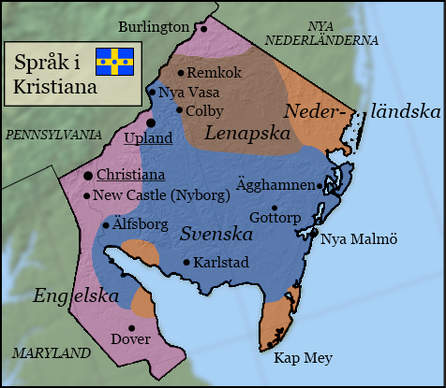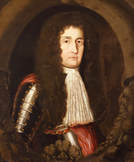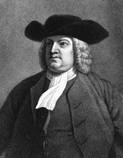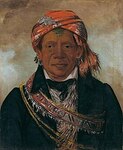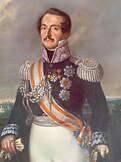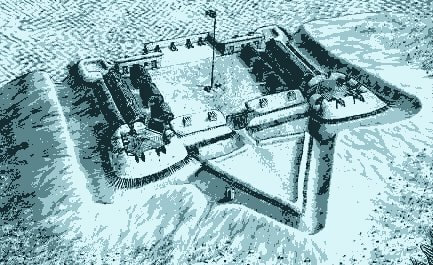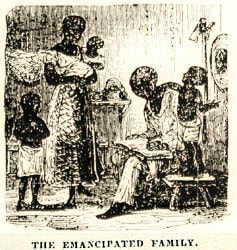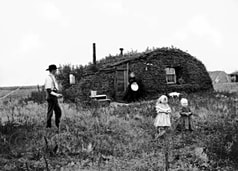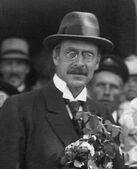This is a first version of a map of Acadia. I plan to add a lot more to it later.
Acadia is a region of four states: East Acadia, New Scotland, St. John's Island, and West Acadia. Northeastern New Hampshire also is part of the historic Acadia and is sometimes included, especially its exclave Madawaska, whose population is unmistakably Acadian. The four states have a great deal of shared culture and history. Most of the region is rugged and forested, with the exception of the gently rolling St. John's Island. A similar mix of peoples can be found throughout the region, in different proportions. Five main groups helped to found Acadian culture: Mik'maqs, French Acadiens, Gaelic-speaking Highland Scots, Anglophone Lowland Scots, and New England Yankees. Their history in Acadia is one of rich interaction and shared political structures.
Acadia today is not a federation like the Dominion of New England, but the four state governments cooperate on many matters. There is a Council of Acadian States consisting of the four heads of state government plus ministers of the areas in which the states cooperate, such as highways, ports, culture, and tourism. Council meetings rotate between the four state capitals.
The History of Acadia
Chapter 1: Arrival of the French and Scots
In 1605, Port Royal became the site of the first successful French habitation in America. A small number of families arrived in the following years, establishing seigneuries and villages around the port and at Cape Sable to the south. English raiders dislodged the French from their capital in the 1620s, and in 1629 a party of Scottish settlers under Sir William Alexander (later Lord Stirling) arrived at the site and established a settlement of their own. When the hostilities concluded, there were thus two small, struggling colonies, one Scottish, one French, competing for the same area of land. Like France, Scotland tried to encourage the development of the land through grants of titles and feudal rights, creating the New Scotland Baronets. As Scottish settlers trickled in, they and the Acadians settled into a pattern of ongoing low-intensity conflict.
The civil wars that began in the 1640s upended the British world. All the colonies were neglected; some lost territory as their progress of the early 1600s was eroded. But the wars were especially consequential for New Scotland because while the royalists ultimately triumphed in England, calling back Charles II after the excesses of the Commonwealth regime, in Scotland the Covenanters won the day. New Scotland was therefore taken out of the wide orbit of the English Empire and became the unique, special project of a new aristocratic republic.
Now with no crown united with England, Scotland found that its interests aligned better with those of France, just as they had in the Middle Ages. The overarching strategy of both nations was to circumscribe English power as much as possible. So not long after the end of the civil wars, Scotland and France rekindled the famous Auld Alliance. In America, this meant an end to competition between the New Scots and the Acadians. Instead they made an agreement of shared occupation. Colonists brought over by Scotland would be subjects of the New Scotland colony; those brought over by France would belong to Acadia. For the moment, the two powers did not bother trying to draw a boundary line between their two colonies and allowed them to overlap. This shared occupation lasted, in one form or another, for more than two hundred years.
The arrangement brought with it some difficulties, despite the lasting friendship between the two colonial powers. The Acadians outnumbered the New Scots by a considerable amount and differed from them in religion. Scottish officials feared that their colonists would be absorbed into French culture and papism if they did not augment their numbers somehow. Some effort was made to entice French- and German-speaking Protestants, but it was too little to solve the colony’s manpower problems.
After the 1710s, a new element began to leave old Scotland for the new: the Highlanders. Clannish, Gaelic-speaking, Catholic, and royalist - usually Jacobite - the Highlanders were far from the model colonists that Scottish authorities wanted. But the desire of their landlords to squeeze out more profit, and the retaliation that they faced after a failed Jacobite uprising, compelled growing numbers of Highlanders to seek opportunity elsewhere. The English colonies drew a few, but for most, passage to Scotland’s colony was much easier to arrange. Coming in families and clans, they obtained land to farm in the central part of peninsular New Scotland.
The Highland Scots and Acadians who found themselves living side by side had much in common. Besides a common religion, they shared a similar attitude toward their new home. Unlike the acquisitive farmers of New England and the long-distance traders of New France, the Highlanders and Acadians both desired little more than a simple, communal peasant existence. They wanted prosperity for their extended families but were not primarily motivated by profit. It was not long before the two groups began intermarrying. This vexed authorities in both France and Scotland, because the new blended families felt more loyalty to their local villages than to either colonial power. All the qualities normally used to describe the people of Acadia - stubborn, independent, provincial, egalitarian, peaceful, devout - are based on stereotypes, to be sure, but they go back to this historical meeting and blending of two marginalized peasant cultures.
Another sign of lurking tension between Scotland and France was the construction of new forts during the eighteenth century. Each side wished for strongholds and blocks of territory under its unrivaled control. Scotland fortified Port Royal and built the fortress of Stirling on the opposite coast of the peninsula. It also established trading posts in West Acadia, from which Lowland Scots traders first began dabbling in the lucrative fur trade. The French built Louisbourg on Île Royale, one of the strongest fortresses in North America. This allowed them both to guard the approach to Québec and to mark off the island as a purely French stronghold somewhat separate from the regions of shared occupation.
At the same time, the alliance encouraged productive cooperation between the Scots and French. This can be seen most clearly in the New Scots’ steadily increasing participation in the Canadian fur trade. French mercantilism prevented the Scots at this point from investing heavily in the trade as they would in the early nineteenth century, but many of the more prosperous and enterprising colonists, largely English-speaking Lowlanders, were beginning to play a role. Some investors acted as middlemen, obtaining contracts from Canada and subcontracting in turn teams of voyageurs who bought furs in the Upper Country. Others operated illegally or semi-legally, sponsoring coureurs de bois on their own. The Scottish fur trade was centered at Port Royal and some smaller posts on the rivers of West Acadia. Some Canadians were already denouncing the Scots as economic parasites of their own rightful trade, but in fact Scottish capital was doing much to give life and energy to Canada’s often stagnant mercantilist system. The partnership benefited both Canada and New Scotland, and indirectly French Acadia as well.
By the middle of the 18th century, Acadia contained two established, allied, overlapping colonies. Its oldest settlements had more than a century of history, its colonial populations had put deep roots into the land. The Acadians and the small but growing population of Highlander New Scots, together with the much older population of Mikmaqs, had a common religion and many similarities in culture and lifestyle, which together with political alliance allowed for an ease of physical and social movement among settlements belonging to the separate powers. The centers of Scotland’s power were Port Royal and Stirling, while French power rested on Louisbourg and Île Royale. In many ways Acadia seemed to sit peacefully apart from the turbulence of North American politics; while raids by New Englanders were always a threat, the people devoted themselves to subsistence and family and in general tried to stay out of colonial warfare.
Chapter 2: Concerning Independence
The Wars of Independence in New England and Virginia were felt in Acadia. They exposed some of the tensions that lay dormant beneath the colonies’ peaceful exterior. Trouble started when France moved to strengthen Louisbourg against possible English attack and ordered the Acadians of the island to contribute their labor and service. Most of the peasants consented to manual labor with little enough fuss, but many drew the line at military conscription. Some outright refused to take up arms. After 150 years of benign neglect, the Acadians did not welcome interference by the home country in their lives. From this point, France would have to struggle to keep its little colony under control.
Locals in Acadia were also wary of France and Scotland’s official support for the English Republicans. They feared that an independent New England would be a greater threat to their territory, and indeed republican New Hampshire and Massachusetts soon began to build forts along unoccupied stretches of the Acadian coast, including Passamaquoddy Bay and the mouth of the St. John’s River. Members of New Scotland’s provincial assembly passed a resolution urging an armed neutrality to defend the colony against English loyalists and republicans alike: they saw both sides in the war as equal threats. French Acadia had no developed representative institutions at this time, but the governor met often with informal delegations of village leaders, and many of them also urged neutrality.
Along with these diplomatic concerns, the Wars of Independence inspired locals looking for more autonomy, especially among the New Scots. Scotland’s control over its colony had never been particularly strong, so when the colonists began to question the need to maintain connections with the mother country, there was little that authorities could do to force obedience. In 1772 the governor dissolved the assembly when it considered a motion of independence. The delegates convened in a tavern a few blocks away. The story still circulates that the deputies happened to be drinking one night when they decided to declare independence. This is wrong for two reasons: first, as noted, Their Excellencies were only in the tavern because the governor had shut them out of their regular meeting place; second, they did not actually declare independence at that meeting. Moderates prevailed upon the assembly to send a delegation to Edinburgh to negotiate a compromise. After months of backroom politicking, the delegates won for their province a status close to independence, but with a few constitutional provisions maintaining ties to Scotland. The Dominion of New England served as a model, but without a monarch to serve as the focus of loyalty, the ties were mostly a matter of free trade and movement, mutual defense, and protection for Scottish investments in the New World. One of the two colonizers of Acadia thus bowed out.
One other area of dispute was the dozens of well-to-do families in Scotland - the New Scotland Baronets - who possessed grants of land in the New World, the vast majority of whom had never done anything to develop or make good on their claims. They continued to regard their grants and titles as their own property. As many sat in Parliament, they were a great impediment to negotiated self-government for New Scotland. Since the land was actually possessed by various smallholders and village communes under various kinds of titles, making good on the land grants was out of the question, no matter what kind of government New Scotland had. In the final deal the baronets got the retention of their titles and a token compensation for the land, to be paid over a number of years. The few baronets whose ancestors had actually done something to develop their land, and who remained in active possession of it, were allowed to keep it, with the understanding that most of their feudal rights would be abolished in the coming years. The very small number of baronets actually resident in the state would likewise be entitled to keep their land as well as have seats in the provincial assembly. This rule remains in effect today, and any New Scotland Baronet residing in the province is also entitled to sit and speak as an MPA, although he may not cast floor votes.
Independence did not end the shared occupation of Acadia, but it did greatly change the nature of it. Instead of a shared colonial space, Acadia now was a land containing one colony and one independent province. The matter of the divided loyalties of the people dwelling in the middle now became more significant, because those of mixed or uncertain ancestry could now choose between being citizens of a new, free republic, or subjects of the French Crown. New Scotland made little conscious effort to entice these people into its body politic, but the advantages and the dignity of citizenship were enough to draw many in, and the last decades of the eighteenth century saw a gradual movement of the population of the peninsula from ambiguous or Acadian loyalty, to adherence to New Scotland.
The same years saw come to pass what all the people of Acadia had feared: the expansion of a newly emboldened, independent New Hampshire and the arrival of Yankee immigrants to the region. New Hampshire extended its reach until it all but controlled the whole territory west of the St. John’s River. New Scotland and the French were powerless to block it; their settlements in the area were sparse. Yankee settlers came in substantial numbers to the southern tip of the peninsula, where they founded the town of Yarmouth, and to St. John’s Island. They bought land with the acquiescence of private landowners and local officials. Leaders in the capitals were alarmed at the thought that New Englanders might overrun the entire region. Fortunately, continental diplomacy kept peace between the states; New Scotland became a member of the Anglo-American Congress around 1800 and secured recognition of its territorial integrity. This diplomatic step was momentous for New Scotland, which had hitherto been seen largely as part of the French sphere in North America.
Meanwhile, the relationship between France and the Acadian people remained complex as ever. The War of the League of St. Joseph (1803-1808) pitted France against England once again; and once again, the Acadians found themselves pressing for neutrality. As their fathers had done a generation earlier, many Acadians refused to take up arms for France. New Scotland likewise armed itself for defense but stayed out of the war. Clearly, France had to act if it wanted to keep control of its stubborn little colony.
Part 3: The Empire
By now, France had been through its own share of troubles. Revolution had given way to Empire, and Napoleon was seeking a way to draw in the frayed edges of France’s overseas possessions. He in fact devoted more resources to the colonies and less to Europe, declining to invade Russia and maintaining his regime for a generation longer than in our timeline. He sent his brother Jerome to Canada to rule over all of New France, and Acadia alone among the smaller colonies received extra attention: another Bonaparte brother, Lucien, to rule as Prince.
Why did Napoleon choose Acadia for his brother? In part, it was simply as a kind of soft exile: he found Lucien’s liberal views and his marriage to a commoner deeply embarrassing, and sending him to Acadia was a way to be rid of him. But he also considered practical matters of governance. Unlike Louisiana and Dominica, which had recently challenged French rule in armed revolts and would respond with anger to the arrival of an imperial prince, Acadia was seen as a wayward province where the people loved liberty but had sympathies basically favorable to France. Becoming the seat of a member of the imperial family might flatter them, as long as he did not try too forcefully to impose his will. In addition, Acadia’s proximity to Canada was seen as an advantage. If Jerome had to leave Québec to deal with some emergency, Lucien could step in to manage things in the capital.
The new prince proved to be the right man for his time and place. His liberalism and lack of pretension, embarrassing to the emperor, helped endear him to the Acadians. Lucien established a monarchy that was largely devoid of aristocratic trappings. His five residences around the region were all modest country houses little grander than those of the more prosperous farmers and fishermen among his subjects. Lucien was also a sincere Catholic and supporter of the Pope, a trait that further served to endear him to his new subjects.
The prince applied himself to reforming the government of Acadia. His first priority was sorting out the tangle of local government caused by a century and a half of shared occupation. Together with the New Scots, he formed a plan to more clearly define the authority of each state. Towns and districts in which either Acadian or New Scottish citizens formed a two-thirds majority would be governed as constituents of that single state. Districts where neither population reached the two-thirds threshold would be governed by joint local councils and considered shared territory. The agreement finally brought some order to Acadia’s geography. Carrying it out required accurate censuses and surveys over the next several years. They revealed a hard truth for the French: that the last few decades had steadily eroded their influence in the peninsula, which was now almost wholly composed of New Scottish citizens.
Lucien instituted other reforms as well. He abolished the vestiges of slavery and the seigneurial system. He introduced the Code Civil. He convened an elected assembly and largely left it to do its legislative work unimpeded. He supported religion and sponsored the construction of new churches. Using his connections in Rome, he arranged for the establishment of Acadia’s first bishopric. The new Bishop of Louisbourg had the entire region, plus the Catholics in New England, as his province. This was seen as a diplomatic coup over New Scotland, which had been trying unsuccessfully to make Port Royal the seat of a prelate.
This era came to an end in 1833. The death of Napoleon II in France left a succession crisis that ended with the rise of the Second Republic. The larger states of New France, animated by the revolutionary spirit, at last cast off colonial rule permanently. Acadia was the only colony where the new republic was able to assert its control. Lucien departed into exile in Italy, but some of his family chose to stay in America, settling in the Anglophone states of Pennsylvania and Maryland. After twenty years as a self-governing Principality, Acadia returned to the status of a colony.
The period of the French Revolution and Empire was also the time when New Scottish investors reached the height of their power in the western fur trade. Mercantalist monopolies were relaxed, and the historically good relations between New Scotland and New France allowed merchants from Stirling and Port Royal to create new, vibrant companies that soon became a dominant force in the Upper Country and Assiniboia. Many of the Canadian Métis who now live in those regions arrived as employees of New Scottish fur companies. Rivalry could be intense: fighting broke out in 1820 in Assiniboia between traders from New Scotland and Rupertsland. The battle is considered a precursor to the later conflict in which Assiniboia left Rupertsland to join the ASB. The trade did much to enrich the New Scottish cities. The main public buildings, including the Governor’s Palace and the House of Assembly, date to this era and were paid for in part by western fur profits.
Chapter 4: Rise of the Four States
In Acadia the Republic established a regime whose goals were good government and respect for individual rights, building on the solid foundation of the Bonapartist reforms. But the French Republic’s centralizing instincts guaranteed its unpopularity among the Acadian people. For example, France gave Acadia the right to elect members of parliament in Paris. Though intended to be a gesture of liberality, the thought of being treated as any other French departement offended many Acadians. Such misunderstandings ensured that Acadia’s remaining sixteen years as a colony would be fraught with political conflict.
The first dispute happened in peninsular New Scotland. Under the terms of the agreement for local government made in the 1810s, most of the peninsula was New Scottish territory because two-thirds of its population was made up of New Scottish citizens. But the Acadians who remained there were still, legally speaking, citizens of France. France now decided to attempt to tax them. This proved a great blunder, opposed by the people and New Scotland’s government alike. France actually called out the militia to try and enforce its policy, and New Scotland did the same. There was no bloodshed, largely because once again the Acadian people were not willing to use military force against their neighbors. The episode resulted in a new agreement that drew the first true border between the two states. Most of the peninsula was surrendered to New Scotland. That border, with a few small adjustments, remains in place today.
Another conflict occurred in West Acadia. As part of a final border agreement with New Hampshire, France desired to fortify Nashwaak on the St. John’s River. In doing so it had to displace a few Acadian farmers already living there. Furious, they left that spot and moved a few dozen miles upriver to Madawaska. There they tried to establish an independent republic, resisting control by both Acadia and Canada. Eventually the Madawaskans chose to become part of New Hampshire.
By the 1840s, the people of West Acadia and St. John’s Island were tired of the shared occupation. A movement was growing to break away from France and New Scotland and become states in their own right. Canada and other states, through the Congress of the Nations, eagerly supported the secession of both regions. To the chagrin of officials in France, both formed regional councils. Propelled by its large Yankee population, St. John’s Island voted to become a fully separate state in 1842. West Acadia was more ambivalent. The Mikmaq and Francophones, both white Acadians and Acadian Métis, were strong supporters of statehood. They resented the political power of the French on Île Royale and wanted to break away. But the Anglophone Scottish population, who dominated the region economically, believed that statehood would impose financial burdens for which West Acadia was not ready. So there the condominium remained in place, but most people believed it would separate eventually.
Acadia itself was part of the ebb and flow of French politics during these years, and the major parties of the Metropole all played a role in the colony. But Bonapartism had a special appeal in Acadia, because in the people’s minds it was linked to the era of self-government under the Principality. Bonapartist politicians spoke often of a restoration, but it was not until 1849 that the party had the strength to act. A Bonapartist majority in the assembly passed a resolution to restore the son of Lucien Bonaparte to his rightful place as Prince of Acadia. It was Acadia’s declaration of independence. In Two Forts, Congress debated whether to give its blessing to the separation. A few delegates profoundly worried that the final ejection of France from North America would harm the stability of the confederation. In the end they were persuaded to abstain from the final vote so that Congress could give its unanimous approval to Acadian independence. With the weight of the ASB behind it, Acadia broke away with no fear of counterattack.
Just as Lucien had been the right prince for his time and place, so was his son Charles well suited for his new role. He was a mild-mannered man, interested in politics but truly inspired only by ornithology. He had lived most of his life in America, having moved to Acadia as a child and spent his adult years in Maryland, New England, and Huronia. He was content to serve as a ceremonial monarch and represent his family and the imperial past, while leaving government to the elected officials. He took an interest in the affairs of state and met constantly with the politicians, but his politicking mostly went on behind the scenes.
For example, Charles persuaded the new government to abandon its claim over West Acadia. The condominium had become a burden for all parties, and the Acadians in the western region had not been an important part of the Bonapartist movement that had brought Charles to power. The end of mercantilism meant that possessing West Acadia was no longer much of an economic benefit to the East. Better to separate now and end the confusion over the West’s status. The East Acadians hoped that New Scotland would simply follow suit and allow West Acadia to become its own state at last. This the New Scots were not prepared to do; they still viewed their western land as a vital connection to the St. Lawrence River and the fur trade, and the New Scots living in West Acadia continued to oppose statehood. Nevertheless, East Acadia unilaterally dropped its claim, and West Acadia therefore became an autonomous region of New Scotland only. After two hundred years, the shared occupation came to an end.
The shape of modern Acadia took its final form in 1866 when West Acadia finally rose to statehood. The west had seen much development in the fifteen years prior. Railroads were encouraging the growth of towns, and in the towns new banks and schools had appeared: the infrastructure that was needed for a modern state. This was during the administration of Premier Armand Linville at the confederal level, and a spirit of democratic reform was again animating many throughout the ASB. Many other states, besides the West Acadians themselves, now prevailed upon the New Scots to release their possession without a fuss. They had to bow to the pressure. The Acadia that we know, a region of four separate states, came into being.
